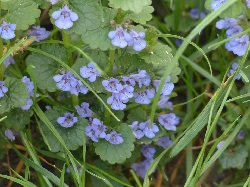ManageSafe™
Least-Toxic Control of Ground Ivy Choose a different pests

|
Identification
Pest type: Plants
In-depth information:
Ground ivy (Glechoma hederacea), also known as creeping charlie, is a perennial broadleaf weed of both warm and cool season turfgrass. Ground ivy infestations are a common problem in both residential and commercial lawns, and to a lesser degree on golf courses and athletic fields. Ground ivy is commonly found in moist, shaded environments where turf is thin; however, it can also be found in areas of full sun. Control of ground ivy in warm and cool season turf can be challenging.
Ground ivy is a perennial that can form dense mats that often creep out of shady moist areas into areas of full sun. Leaves are kidney shaped, and when crushed, emit a distinct odor similar to mint. Ground ivy produces blue to purplish-colored flowers in spring that appear in clusters of three. Primary growth occurs during spring and fall, but ground ivy can be found throughout the growing season.
Is it a problem?
Weeds may cause allergies or lead to skin rash on contact. Most weeds are simply a nuisance because they are considered unappealing in a lawn. A few weeds should be tolerated, but weed infestations that overtake turf grass are signs of unhealthy soil. Ground ivy can be ornamental, but it tends to grow in thick mats that chokes out other vegetation. It is also toxic to horses if eaten in large amounts.
Pest prevention practices
Remove potential habitat
Foster natural resilience
In-depth information:
Having healthy soil, using at least two native turfgrasses, proper watering, and a sensible landscape design can all help your lawn ecosystem develop a natural resistance to weeds. Indeed, ground ivy and other weeds in your lawns are often a sign that the balance of your soils are off. Excessive watering, poor drainage and too much shade tend to promote ground ivy growth, so using proper watering techniques and testing your soil can help you manage weeds in your lawn.
The best defense against any weed infestation is maintaining a dense, vigorous stand of native turfgrass. Growing conditions that favor turf often discourage the growth of ground ivy. Decreasing shade and soil moisture will create an environment better suited for turfgrass growth and less conducive for ground ivy. Additionally, soil test regularly and apply nutrients in accordance with soil test results.
Monitoring and record-keeping
Keep an eye out in your lawn for areas where ground ivy begins to take root. Once established, this plant is difficult to control because it is hard to remove all root and stolon fragments. Seed banks may also remain viable after control methods are used. Small patches can be pulled by hand or using a rake when the soil is damp. All roots must be removed.
Non-chemical and mechanical controls
Aerate soils
Proper watering
Dethatching
Handpick and destroy
In-depth information:
It is easiest to hand-pull ground ivy when the soil is moist, such as after a heavy rain. If you have a small area of ground ivy and wish to use a mechanical means to eradicate the plant, you may use a sod lifter (a hand tool) or a sod cutter (a power tool) followed by reseeding or the installation of sod. If the area is shady and moist, consider replacing the grass with shade-tolerant ground cover plants or even decorative mulch. Consider improving light conditions by trimming trees and shrubs. To prevent overwatering, water infrequently but deeply when you do.
Biological controls
A rust fungus Puccinia glechomatis attacks ground ivy causing severe damage or death and may hold some potential for biological control. The fungus forms small tan dots on the undersides of the leaves and stems. A severe infection can cause death of a whole leaf segment or an entire stolon and all its leaves.
Least-toxic chemical options as a last resort
- Horticultural vinegar, or acetic acid, is also effective at killing certain weeds. Avoid spraying other green vegetation, such as turfgrass, since this is a nonselective plant killer.
- Herbicidal soaps are highly refined soaps that can penetrate the waxy coating on plant leaves, causing them to dry out.
Chemicals to Avoid
Look at your product labels and try to avoid products containing those chemicals listed below:
(A = acute health effects, C = chronic health effects, SW = surface water contaminant, GW = ground water contaminant, W = wildlife poison, B = bee poison, LT = long-range transport)
|
2,4-D | Glyphosate |
Social Media
See what other folks are saying about this, and let us know what works for you.
Gaining Control of Ground Ivy: Welcome Back to Question of the Week!Question: I noticed that there is some ground ivy...
Posted by Beyond Pesticides on Friday, March 25, 2016
Click the post above to view and comment on Facebook, or comment directly on this site below.








